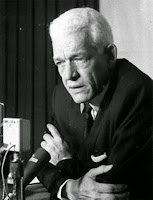Above: Protests opposing and supporting the U.S. occupation of the Dominican Republic. The top picture reads, "July 12th, Get Out Yankees" in Spanish, while the other sign reads in English, "Yankees Come Back."
Above: (left) Rafael Trujillo, (right) Juan Bosch, and (bottom) Elías Wessin y Wessin
The Back Story
In 1961, the Dominican Republic's military dictator Rafael Trujillo was assassinated. After a democratic election, Juan Bosch, the leader of the Dominican Revolutionary Party, took office. Bosch pushed for a series of economic and social reforms, which received widespread support from the rural and urban poor and working classes, but also strong push back from both the military leadership and wealthy Dominicans. In September 1963, there was a coup d'état and Elías Wessin y Wessin would eventually take power while a civil war broke out in the streets of Santo Domingo. During months of fighting, the pro-Bosch forces gained control of the capital city. Fearing another Cuban-styled revolution, Lyndon Baines Johnson ordered the U.S. Marines into Santo Domingo (named Operation Power Pack). The Dominican people remained divided in their support of the U.S. invasion. In 1966 election, running on a platform of peace and stability and with the endorsement of the U.S. government, Joaquín Balaguer (a former official under Trujillo) defeated Juan Bosch. Balaguer would rule the Dominican Republic of-and-on for the next 22 years, with many people considering him a puppet of the U.S. government.
The U.S. Occupation of the Dominican Republic should be an essential component of any Cold War unit in U.S. or world history. First, there are over 1.5 million Dominican Americans in the United States. Dominicans have had a particularly important influence on many communities in New England, New York, New Jersey, and Florida. In fact, the 1965 turbulence and civil war was a major influence on Dominican immigration to the U.S., which dramatically increased from the 1960s through the 80s. In many ways, Dominican Republic history is U.S. history. Second, this is an important place in the curriculum to connect the Cold War to the Latino experience. It is typical that Cuba is the only Latin American country that plays a prominent role in Cold War curriculum units (i.e. Cuban Revolution, Bay of Pigs Invasion, Cuban Missile Crisis). By teaching the U.S. occupation of the Dominican Republic, it allows students to see other incidences of U.S. intervention. Finally, the occupation is an important side story of the Vietnam War. Much like Vietnam, LBJ and the U.S. government used the fear of spreading communism (and a plea to protect American citizens abroad) to justify another use of military force. It is also a prime example of American imperialism during this period and should be taught in conjunction with the first U.S. occupation of the Dominican Republic (1916-1924) and rooted in the long history of military force used by the U.S. in Latin America and the Caribbean, including Cuba (1898/1961), Puerto Rico (1898), Panama (1908/1912/1989), Haiti (1915/1994), Guatemala (1954/1966), Nicaragua (1981), El Salvador (1981), and Grenada (1983).
I would suggest that students use the below sources to examine the following inquiry question: Was the United States justified in occupying the Dominican Republic in 1965?
Primary and Secondary Sources:
Overview: Dominican Republic Historical Timeline (2014): news.bbc.co.uk/2/hi/americas/country_profiles/1217771.stm
Overview: The U.S. in the Caribbean, 1877-1920 by Jason Colby (2015): www.gilderlehrman.org/history-by-era/empire-building/essays/united-states-and-caribbean-1877%E2%80%931920
Essay: Occupation by the United States, 1916-1924 by Richard A. Haggerty (1989): countrystudies.us/dominican-republic/10.htm
Primary Source: TIME Magazine Article on Trujillo's Rule (1945): content.time.com/time/magazine/article/0,9171,886652,00.html
Primary Sources: U.S. Occupation of the Dominican Republic: www.utexas.edu/cola/orgs/hemispheres/_files/pdf/newsletters/cold_war_docs/DominicanCrisis.pdf
Primary Source: U.S. Military Newsreel: Marines in Action (1965): www.youtube.com/watch?v=jbhJ7v6wkrM
Primary Source: LBJ's Speech on the Dominican Republic (1965): www.youtube.com/watch?v=sOYKHY2mBmQ
Primary Source: British Newsreel: Dominican Revolt (1965): www.youtube.com/watch?v=Z6oS3BGABTc
Primary Source: TIME Magazine Article on the Military Coup: content.time.com/time/magazine/article/0,9171,898727,00.html
Report: LBJ on Dominican Republic by David Coleman (2015): nsarchive.gwu.edu/NSAEBB/NSAEBB513/
Report: Hope Denied: The U.S. Defeat of the 1965 Revolt in the Dominican Republic by Piero Gleijeses (2014): www.wilsoncenter.org/sites/default/files/CWIHP_Working_Paper_72_Hope_Denied_US_Defeat_1965_Revolt_Dominican_Republic.pdf
Editorial: Dominican Republic 40 Years After U.S. Occupation by Juleyka Lantigua (2005): www.progressive.org/media_la2505
Editorial: LBJ's Other War by Rory Fanning (2015): www.jacobinmag.com/2015/04/dominican-republic-occupation-united-states-1965/







